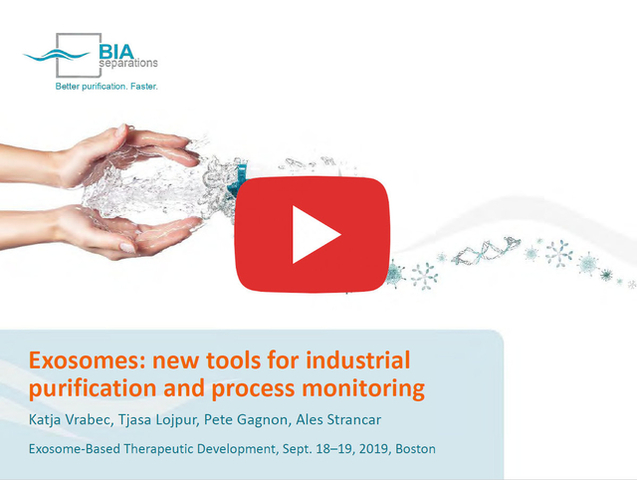Seminars & Webinars
2021
Presenter: Aleš Štrancar
Event: Genetic Vaccine Development for Infectious Diseases Summit
Date: May 20, 2021
Abstract:
- Developments in gene therapy and threat of pandemics requests novel technologies to allow for efficient manufacturing of very large biomolecules and nanoparticles within short time.
- Convective Interaction Media with open channel structures resulting in no shear forces allows for fast and very efficient manufacturing of mRNA, pDNA, Adeno and other VLP based Covid vaccines.
- Ultra-sensitive DNA assay and fast in-process control using PATfix systems are introduced for production of safer Covid vaccines.
Attachments
Event: BioProcess International COVID-19 Therapeutic Development & Production
Date: April 27, 2021
Developments in gene therapy and the threat of pandemics requires novel technologies to allow for efficient manufacturing of exceptionally large biomolecules and nanoparticles within a short time. Novel vaccine platforms such as mRNA enable the industry to meet its highest goals: decreasing footprint while increasing efficiency and throughput. However, to respond with agility and prepare for future outbreaks, the mRNA platform must be further optimized.
In vitro transcription (IVT), the enzymatic process used for mRNA vaccine production, is different from biological fermentation processes as it requires linearized plasmid DNA. The linear isoform is produced with restriction enzymes from open circular and supercoiled pDNA. Employing a traditional pDNA manufacturing process, which removes multimers as well as linear and open-circular isoforms, reduces production yield.
However, when pDNA and mRNA are treated as a single production process, the purification steps are optimized, yields improved, and overall production costs reduced. This presentation will describe how Convective Interaction Media monoliths can be used to efficiently purify a board specter of mRNA and cover all production scenarios.
This presentation illustrates fast in-process control methods using the PATfix system, which can ensure the rapid production of the safest possible Covid-19 vaccines while reducing manufacturing costs.
Attachments
Event: Nucleic Acids- cGMP Production of mRNA & pDNA (virtual edition)
Date: February 1, 2021
Our new Head of Process Development for mRNA and pDNA purification, Rok Sekirnik, presented our Chromatographic tools for high-yielding mRNA production process as workshop.
Click here to listen to the workshop.
Event: Nucleic Acids- cGMP Production of mRNA & pDNA (virtual edition)
Date: February 3, 2021
Our CEO, Ales Strancar presented our Integrated Production Process of mRNA from E. coli to Highly Purified mRNA
Attachments
2020
Presenter: Aleš Štrancar
Date: od demand, October 19-22, 2020
Cell & Gene Therapy Bioprocessing & Commercialization (digital event)
Established processes for pDNA manufacturing include purification steps designed to enrich the supercoiled (sc) isoform. Homogeneous supercoiled isoform improves cell transfection efficiency in fermentation processes and is favoured in cell culture production systems. In vitro transcription (IVT), the enzymatic process used for production of mRNA vaccines differentiates itself from biological fermentation processes by the need for linearised plasmid DNA. The linear isoform is produced with restriction enzymes from open circular and supercoiled plasmid DNA. Employing a traditional pDNA manufacturing process, which removes linear and open-circular isoforms, will therefore reduce the production yield. When plasmid DNA and mRNA are treated as a single production process, the purification steps can be optimised, yields improved, and the overall production cost reduced.
A new purification approach starting from E.Coli all through to mRNA production is presented here. This new approach integrates a pDNA linearisation step before polishing of plasmid DNA. The polishing step, placed after enzymatic linearisation, purifies linear pDNA from enzyme and other unwanted process impurities. The linearised plasmid DNA is then used in IVT for production of mRNA. This approach further introduces mRNA purification tools for improved contaminant removal. The altered sequence of purification and linearisation reduces the overall number of purification steps required, improves recoveries, while the complete process results in extra low protein impurity and very efficient dsRNA removal.
Attachments
Presenter: Aleš Štrancar
Date: August 27, 2020
2nd Bacteriophage Therapy Summit 2020 (digital event)
Many of the most compelling applications of bacteriophages involve human therapy, some pertinent to gene therapy, others to antibiotic replacement. These applications require removal of host cell contaminants to acceptable levels, including proteins, DNA and, most of all, endotoxins. This presentation will highlight some of the challenges with effective endotoxin removal, and introduce a new chromatography product that achieves good endotoxin removal while maintaining high recovery of bacteriophage. Case study data will be shared documenting the performance of a platform purification method that enable complete bacteriophage purification within a single shift. Fast analytical methods for qualification of raw materials and tracking phages through the steps of a purification process will also be presented.
Attachments
Presenter: Pete Gagnon
Date: 23rd of January 2020
Place: Miami, FL (Phacilitate World Stem Cell Summit)
Attachments
2019
Presenter: Pete Gagnon
Date: September 18, 2019
Place: Boston, MA (Exosome Based Therapeutic Development Summit 2019)
Attachments
Presenter: Ales Strancar
Date: 19th of June 2019
Place: Biomanufacturing Training & Education Center (BTEC) in North Carolina

